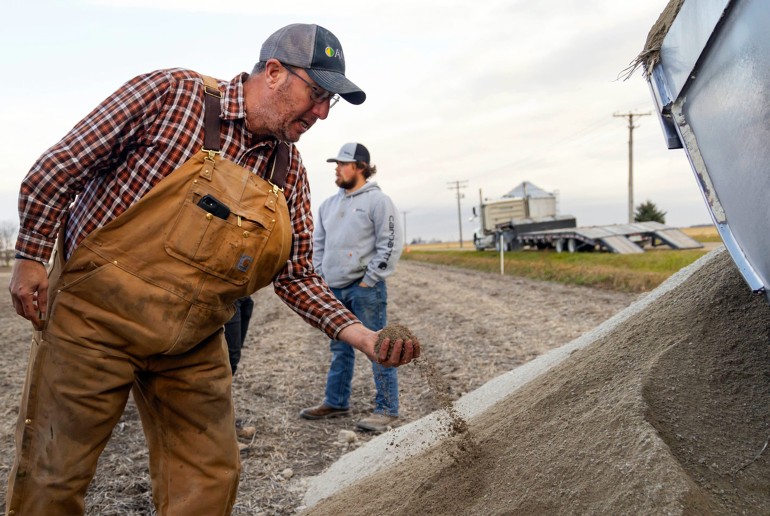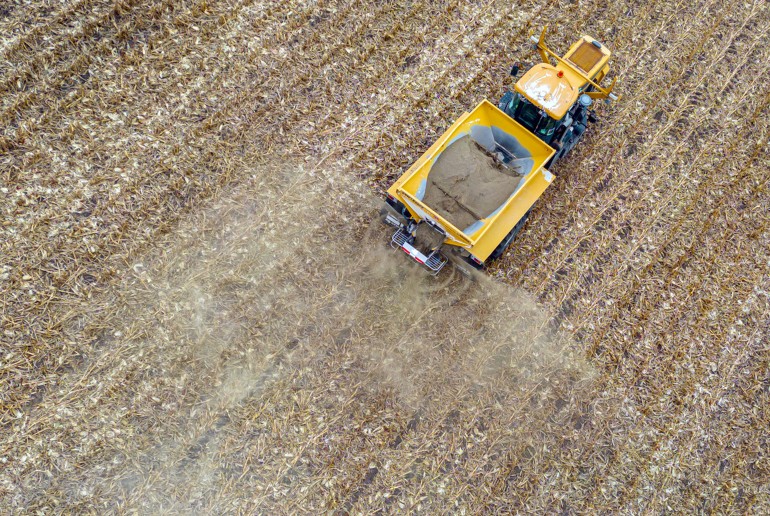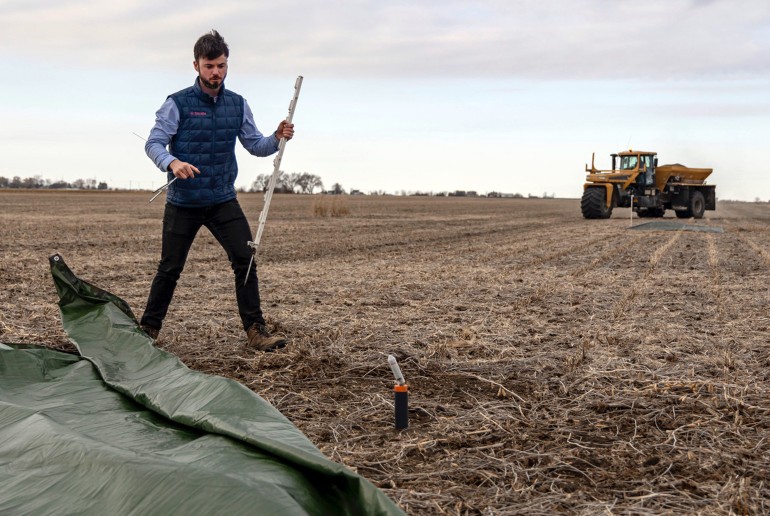
Testing Limestone’s Ability to Capture Carbon From Air
Published by Todd Bush on November 25, 2024
Northwestern’s DOE-funded project will kick off in January 2025 at a farm in downstate Illinois
A Northwestern University-led team of interdisciplinary researchers has received $5.1 million from the U.S. Department of Energy (DOE) to test the efficacy of enhanced weathering, a relatively new strategy to remove carbon dioxide (CO2) from the ever-warming atmosphere.
Sprinkling crushed rock onto farmland could remove billions of tons of CO2 from the atmosphere annually — and successfully trap it for tens of thousands of years. But researchers still need to perform more in-depth research and analysis to determine whether enhanced weathering represents a plausible decarbonization pathway.
With the new grant, the team will distribute crushed limestone on a downstate Illinois farm and analyze its ability to remove atmospheric CO2. Farmers already employ limestone to control soil pH and improve crop yields, but little research has been done to optimize existing practices to promote CO2 drawdown.
Kicking off in January 2025, the project is part of a $58.5 million DOE investment into the development of commercially viable carbon-removal technologies.
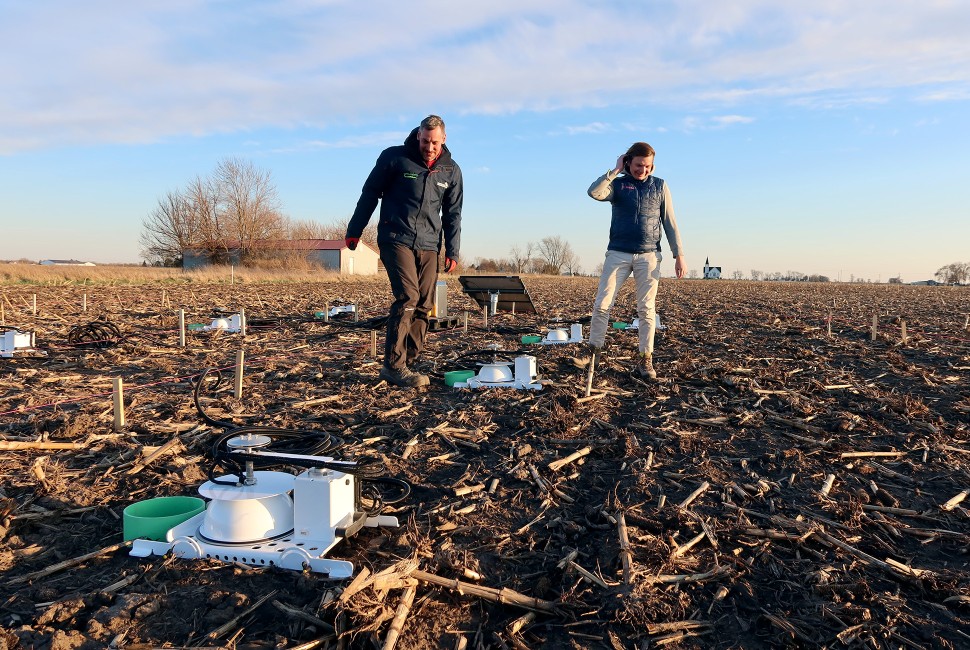
Silicate Carbon's Maurice Bryson (right) and his colleague set up flux chambers on Schott's Farm. The chambers measure gas emitted from the soil, including methane, carbon dioxide and nitrous oxide.
>> In Other News: Manchin, Capito Announce Key Progress in Carbon Storage Permitting for West Virginia
Brad Sageman, professor of Earth and planetary sciences
By collecting and analyzing data from water and soils over two growing seasons, the researchers aim to accelerate the carbon-removal process and develop enhanced weathering protocols that farmers throughout the Midwest and other regions can readily adopt. In addition to providing a safe and durable decarbonization solution, researchers expect enhanced weathering will empower farmers to generate additional income by selling carbon offset credits.
“Within the past few years, interest in enhanced rock weathering has increased exponentially,” said Andrew D. Jacobson, principal investigator on the grant and professor of Earth and planetary sciences at Northwestern University. “The decarbonization industry is rapidly expanding, and Northwestern is ideally positioned to take a lead role to hone enhanced weathering. We are motivated to test enhanced weathering’s potential with the highest levels of scientific rigor and quality.”
Along with Northwestern professors Brad Sageman and Louise Egerton-Warburton, Jacobson will complete the project in partnership with carbon-removal startup Silicate Carbon and Frank McDermott, a geology professor at University College Dublin.
Accelerating weathering from millennia to decades
Proponents of enhanced rock weathering are inspired by Earth’s natural long-term carbon cycle. Rock weathering converts CO2 into bicarbonate, an ionic form of carbon that is relatively stable in water over geologic timescales. Bicarbonate ions filter down through soil and are eventually washed into streams, rivers, and, finally, the ocean, where they form solid calcium carbonate.
Brad Sageman, an expert on Earth’s ancient climate, said, “Once carbon is in its mineral form, it can’t escape. We want to capitalize on the Earth’s natural feedback system. But this process happens over geological timescales. In order for it to make a difference during our lifetimes, we have to accelerate the process from millennia to decades.”
By grinding up rocks — rather than allowing rocks to naturally weather over long timescales — researchers increase the surface area that’s available for chemical reaction. This should accelerate the timescale of CO2 drawdown.
The Northwestern team is collaborating with Silicate Carbon, an Ireland-based company testing the potential of enhanced weathering at Schott Farms in Buckingham, Illinois, a small village outside Kankakee. Last year, Silicate began systematically covering more than 40 acres of the soy and corn farm with fine dust from waste concrete. After multiple false starts — interrupted by a lightning strike and failed solar panels — the team finally began collecting preliminary data from water runoff and emitted gas this past summer.
“It’s amazing work, but we have a shoestring budget,” said Maurice Bryson, CEO of Silicate. “We’ve been doing it with the most minimal budget you could possibly imagine. We are using donated equipment and sheer grit and determination. Now, with the DOE funding, we will be able to perform research at a much deeper level. It gives us the right people, the right resources, and a detailed plan of how to address multiple questions.”

The team examines corn growing at Schott's Farm. After dusting the farm with concrete, soybeans and corn will be planted over the top. Then, plant biologists will study the crops' health. Images by Silicate Carbon
A first for limestone
The DOE-funded study will focus mostly on limestone but will also test other geologic materials, such as basalt and wollastonite. To date, most enhanced weathering strategies have employed basalt, which researchers think weathers faster than other silicate rock types, such as granite. However, limestone weathers orders of magnitude faster than basalt, thus increasing the likelihood that CO2 drawdown rates can be confidently measured.
Maurice Bryson said, “Most teams around the world are using basalt, which is an igneous rock. We know basalt rock weathering is a natural carbon sink over geological timescales, but it is not clear whether it can be a sink for CO2 over human timescales. The potential of carbonates, like limestone, however, to rapidly draw down atmospheric CO2 is very clear, and something that we have been testing for the past three years.”
Erich Schott, owner of Schott Farms, already adds limestone to his fields every five years or so. When soil is too acidic, limestone balances the pH to make nutrients more readily available for his crops. As a part of the new study, researchers will explore whether limestone should be added at more frequent intervals and/or at higher volumes.
Schott feels “cautiously optimistic” about the enhanced weathering project happening outside his window. The farm has been in his family since the 1850s. During his time running the farm, he’s been open-minded about experimenting with new farming techniques.
“If you don’t try different ideas, you will miss any opportunity to learn. If it works, that would be great news. But, if not, we tried,” Schott said.
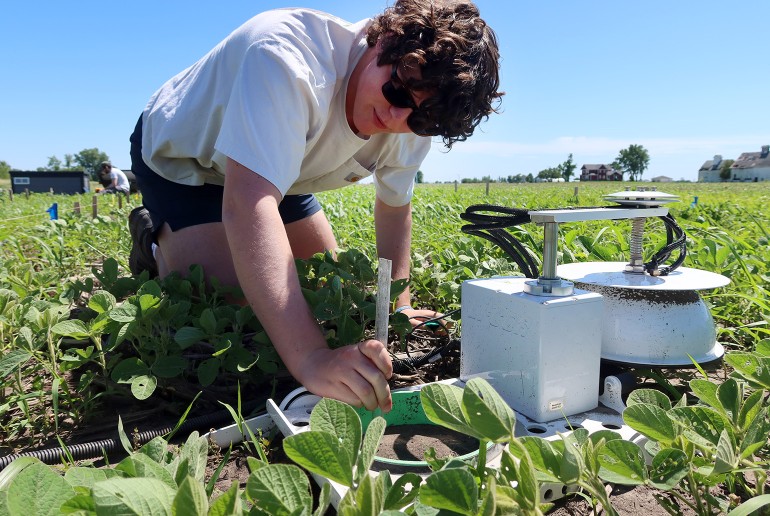
A member of Silicate Carbon sets up equipment to measure water and emitted gas from the soil in a soybean field. Images by Silicate Carbon
Measuring soil, plant health
Similarly, this isn’t the first enhanced weathering study the Northwestern scientists have attempted. Funded by the Paula M. Trienens Institute for Sustainability and Energy, Jacobson also leads a two-year demonstration project to test the CO2 removal efficacy of basalt.
Located inside a greenhouse at the Chicago Botanic Garden, the project comprises dozens of mesocosms (experimental systems that simulate natural conditions). The research team uses these systems to examine the effects of temperature, crop type, and other variables relevant to Midwestern agriculture. As the plants grow, the researchers measure bicarbonate, pH, and dissolved ions in water runoff, as well as crop yields and gases emitted from the soil.
After these experiments conclude, the researchers plan to have results that could guide the effort to optimize and predict CO2 removal. While enhanced weathering alone cannot reverse climate change, it could be yet another tool to slow warming.
Maurice Bryson said, “Climate change is here, and the world is not adjusting its behavior just yet. So, we have to think of new solutions that can help reduce the effects of burning fossil fuels. It’s going to take a lot of work, but it’s a challenge that we absolutely must pursue.”
Subscribe to the newsletter
Daily decarbonization data and news delivered to your inbox
Follow the money flow of climate, technology, and energy investments to uncover new opportunities and jobs.
Latest issues
-
Why Texas, Arizona & West Virginia Are Making History
Inside This Issue 🗺️ Three States Just Took Control of CCS Permitting. Here's What It Means. ⛏️ QIMC's U.S. SPV, Orvian, Awarded Two RGRAs From the State of Minnesota to Advance Next-Generation Na...
-
Why Two Korean Giants Just Bet Big on US Wood Waste
Inside This Issue 🌲 Why Two Korean Giants Just Bet Big on US Wood Waste 🧪 Primary Hydrogen Identifies 8-kilometre Hydrogen Anomaly at Crooked Amphibolite Project in British Columbia 🚇 Carbon Captu...
-
This Tech Could Rewrite Hydrogen Economics
Inside This Issue ⚗️ ExxonMobil-BASF Partnership Signals Turquoise Hydrogen's Shift From Lab to Industrial Scale 🧱 API Endorses Use of Portland Cement in Carbon Storage Wells 🤝 CCME Engages at the...
Company Announcements
-
Air Liquide and Aster Sign MOU to Collaborate on Low-Carbon Hydrogen Production in Singapore
November 26, 2025 [JTC] — Air Liquide Singapore, a world leader in industrial gases, technologies, and services, and Aster Chemicals and Energy Pte. Ltd. (Aster), a leading provider of chemical and...
-
VALENCIA, Calif. (BUSINESS WIRE) — H2scan Corporation today announced that the Company's Board of Directors has appointed David Ellis, a notable energy and technology executive with more than 30 ye...
-
Reverion Secures $41 Million in Carbon Removal Deals Led by Google, H&M
Frontier buyers will pay $41 million for 96,000 tons of carbon removals from 2027–2030. Reverion’s system removes CO2 from both methane and biogenic CO2, doubling removal compared to conventional ...
-
Montreal, Quebec (Newsfile Corp. - November 26, 2025) - Québec Innovative Materials Corp. (CSE: QIMC) (OTCQB: QIMCF) (FSE: 7FJ) ("QIMC" or the "Company") is proud to announce that the State of Minn...
